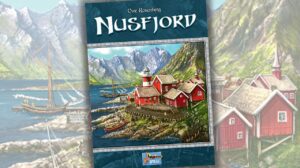Disclosure: Meeple Mountain received a free copy of this product in exchange for an honest, unbiased review. This review is not intended to be an endorsement.
I’m addicted to connections—board game design and criticism give me that special hit because games are dialectical. Their form relies on stringing together familiar operations, abstractions, metaphors. It’s why every time you see a game where people are moving little soldiers around a map you assume that some kind of slugfest is taking place.
Games talk about other games through their mechanics, they are connective tissue between people. Good game design is healthy tissue, linking ideas that have potential and might have otherwise been forgotten.
Feya’s Swamp (or if you have the Spanish version like me, El Pantano de Feya) is a fascinating example of old ideas resurfaced, and I sincerely hope that it makes its way to a larger audience.
If you’re a game genealogy nerd like myself, Feya’s Swamp is a reimagining of Anselm Ostertag and Helge Ostertag’s (the latter is the co-designer of Terra Mystica) game Kaivai, but it is not just their previous game with a new coat of paint. Every system has been optimized and tweaked, though the overall structure stuck around. It remains, like its predecessor, a very punishing game.

Monoswampism
Feya’s Swamp is a fishing game that’s not really about fishing. It’s about building fishing villages. Each player has four tracks on their player board that have identical hex tiles featuring villages serving as unlocks on their tracks. As you build on each track from left to right, you’ll get new workers, new boats, and additional income. If you’ve encountered Terra Mystica, you’ll see echoes.
The game follows a simple worker placement structure, where you send workers to do actions that fall within two categories: actions utilizing your boats, and actions that don’t. In a lovely bit of “making pieces function the way you’d think they should“, the boats are your mobile infrastructure, and they only do things when they have a job. Except for one action, your boats can’t just sail willy-nilly. Boat actions require your boat to perform an action in the boat’s space or move it and take an action.

Usually your boats are building more fishing villages in spaces adjacent to them, fishing (if there is alignment between which colored fish you can gather in a round and your boat is on top of one), delivering fish, or sailing freeform to collect torches, which are instant points.
Building is the most fascinating component of the game, as it utilizes a concept that is rarer than you’d think in modern gaming—enclosure. In a 3-4 player game, there are 9 islands present in the swamp. When you build, you enlarge each island, filling in a hex. The rules aren’t too complicated for the shifting geography—you can never join two islands, block access to one of the corner temple hexes, or block access to another boat.
What this means is that over the course of the game, you’ll create a unique landscape that gets harder and harder to move around in, with choke points, lucrative ports, and annoying blocks.

Sound wide open strategically? Well, each game has two endgame cards, pulled from a deck of 6, that score your buildings differently based on how the islands are formed, so players are incentivized to create different types of islands based on the scoring categories. One game might have tiny islands, another might have a few biggos. Additionally, every island will score a set number of points based on a simple multiplier that I won’t go into here.
Money is your main resource in the game, you need it to build. When you collect fish, you’ll eventually deliver them. When you take a delivery boat action, you move your boats and drop fish off in the fishing villages. If you deliver to other players, you give them deferred points and you get money, and when you deliver to yourself you get deferred points but no money. This creates an interesting tension in the game where you’re incentivized to spread your deliveries across players to maximize the money you get and not over-reward another player.

The non-boat actions are simpler. One increases your sailing capacity (more on this in a moment) while the other allows you to select an island to score, gaining points for islands that have lots of fish on different hexes (you’re throwing a party). The scoring action clears an island to be delivered to again while getting bonus points for the person taking the action.
If I were to simplify how the game works, I’d say it’s a pick-up-and-deliver game where you are constantly reshaping where pickup and delivery can happen. But there’s one more wild bit to talk about.
Turn odor
The original Kaivai featured an auction which has been replaced by a role selection mechanism in Feya’s Swamp, which is for the better. At the start of the game, you’ll select a role card that puts you in a specific spot in turn order, gives you a special power, and determines how much sailing capacity you’ll have and how much buildings will additionally cost you. It’s a delicious decision. The cards generally work this way: earlier in turn order means more movement but exorbitant building costs, later means cheaper builds but less movement. You’ll add your player board’s sailing capacity to the movement value on the card to determine how far your boats will move with each action.
This is the most rules explanation I’ve ever done in a review, and I’ve left out quite a bit of stuff. Feya’s Swamp is an ambitious game in the same way its predecessor was. You’re building a map, trying to balance player positions, creating micro economies, and managing a logistics chain all at once. It’s a difficult game to succeed at. Every turn is engrossing in the 90-120min playtime, but it is extremely easy to mess up.

Each time you play the game, you have to throw out many strategic assumptions from your previous play based on the scoring categories that show up in the flop. Unlike many other games, you have to build a player economy that corresponds with scoring conditions, rather than follow general principles and min/max them.
This results in scores that range wildly. You can have a winning score in the mid 200s or the low 100s depending on how the game is working, and there’s often a 50 point difference between the winner and the last place player. What this means is that every decision is important, and mistakes are punished harshly.
But hey, swamps are dangerous places. If you’re a fan of sandbox-style economic games, this is one to treat yourself to. I’ll be paddling around for some time to come.











How does it play at 2 players?
Not sure, I didn’t have much interest in playing it at that count.